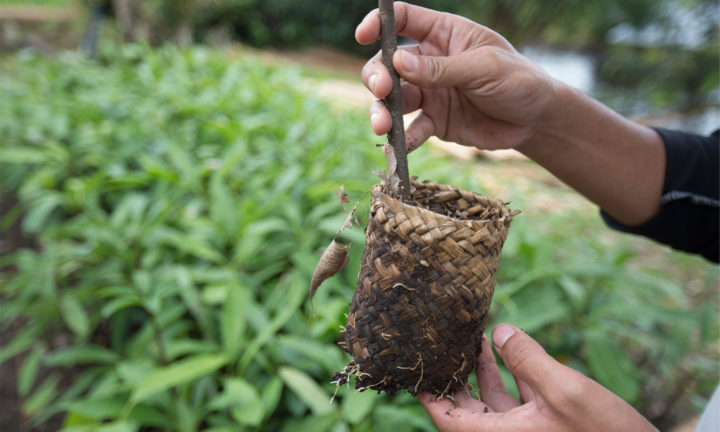Two forest projects in Borneo show the value of a United Nations-backed scheme that protects forests and wildlife, reduces carbon emissions and benefits local communities. This is the second of a two-parter on the carbon credit market.
In the centre of Borneo island are two projects that protect patches of peat swamp forest three times the size of Singapore.
Once threatened with destruction by palm oil and mining firms, these two privately run businesses were early movers in a United Nations-backed scheme called REDD+ that rewards investors who protect nature and fight climate change.
Tropical rainforests soak up huge amounts of carbon dioxide (CO2) and store the carbon in tree trunks, roots and leaf litter. By protecting the forest, every year the Rimba Raya and Katingan Mentaya projects in Central Kalimantan province prevent about 11 million tonnes of CO2 from being emitted – that’s like taking about three million cars off the road annually.
Over its project life of 60 years, Katingan Mentaya, the project’s developers estimate, would prevent 447 million tonnes of CO2 from being emitted, equivalent to the annual emissions of France – all from 150,000ha of forest.
Auto and insurance giants, oil and gas companies, tech firms and others buy carbon offsets from these projects, with each offset equivalent to a tonne of CO2 removed or locked away. The firms use these to meet their own emissions-cutting goals.
The Rimba Raya and Katingan Mentaya projects began more than a decade ago and their success is testament that forest carbon schemes work and, if done right, have the potential to curb the pace of global warming.
It also shows that carbon finance represents a vital, if still small, lifeline to fund conservation of fast-disappearing ecosystems, including mangroves, seagrass meadows and wetlands. If scaled up, the benefits could be immense, potentially unblocking billions of dollars in conservation investments.
“Forest protecting must be done right,” says Mr Dharsono Hartono, co-founder of the Katingan Mentaya project. “Natural forests with healthy biodiverse ecosystems create the best conditions for sequestering and storing carbon. Large-scale tree planting is a fantastic endeavour and should be encouraged, but we must prioritise protecting and restoring the forests we already have.”
Globally, forests soak up billions of tonnes of CO2. But widespread clearing, such as with fires, and the growing impact of climate change are fast threatening this natural brake on global warming.
The world lost an area of tropical rainforest the size of the Netherlands last year, according to a recent assessment by the University of Maryland on the Global Forest Watch online platform of the World Resources Institute. Rainforest loss in Indonesia and Malaysia fell for the fourth year in a row last year, the analysis found, but the area was still about 345,000ha, or nearly five times Singapore’s size. That represents a huge amount of CO2 emitted into the air and a large loss of rich plant and animal life.
True value
The trade in carbon offsets, or credits, occurs through a well-established voluntary market where projects are designed to strict standards and are annually verified, and the credits sold directly to the buyer. Though small – about US$300 million (S$399 million) in 2019 – the market is changing the calculus of valuing nature.
Financing forest carbon projects, or nature-based climate solutions as they are also known, means forests can be worth more alive than dead – especially as demand is growing for offsets from high-quality projects as more and more companies and governments pledge to meet strict climate targets.
And few areas are more valuable than peat swamp forests.
Rimba Raya and Katingan Mentaya sit on carbon-rich peat domes that have accumulated hundreds of millions of tonnes of carbon over the centuries in the form of dead plant matter. Clearing the forest and draining the swamps are a very bad idea: Once dried out, deep peat domes can burn for months and produce toxic haze and lots of CO2.
Both projects are also reserves for orangutans, proboscis monkeys, clouded leopards and other endangered wildlife and plants. Rimba Raya’s 64,500ha also acts as a natural buffer zone to the adjacent Tunjung Puting national park.
Investors are increasingly seeing the potential of forest carbon projects, which are estimated to comprise the majority of future carbon credit flows. Investors, such as Pollination Group, a climate advisory in Australia, and banking giant HSBC, say that nature is greatly undervalued and billions of dollars of investment are needed to create nature as a new asset class.
“It is critical to finance global rainforests,” says Mr Martijn Wilder, Pollination’s founder. “They are not only critical to climate change but also to the preservation of global biodiversity. They are disappearing at a rate of knots and they need large-scale climate finance. And critically they are home to indigenous communities. There is enormous potential for nature if we take the right approach.”
Pollination and HSBC have formed a venture to invest in nature-based solutions, and other major investors around the globe, including Singapore, are also eyeing the burgeoning carbon market. That’s good for Rimba Raya and Katingan Mentaya. Both have seen a surge in buying of their carbon offsets and expect prices to steadily rise from the present range of US$4 to US$8 a tonne, with buyers keen to lock in future flows of offsets even if prices are higher.
Track record
What helps is that both projects have a strong track record and have achieved the highest standards in the market covering carbon sequestration, biodiversity protection and community development. Rimba Raya last year was certified as meeting all 17 of the United Nations’ Sustainable Development Goals.
Both projects use carbon credit sales to support more than 40 villages – 34 for Katingan Mentaya and 11 for Rimba Raya. The projects have developed a wide variety of livelihood and health programmes, including food production as well as employing locals as fire wardens and in tree nurseries for replanting cleared areas. Katingan Mentaya employs more than 400 local people to protect the forest during the fire season and has also replaced “river toilets” with cleaner land-based latrines.
Rimba Raya has expanded its orangutan release sites deep in the forest, is replanting mangroves along the coast nearby and also launched a floating health clinic that travels along the Seruyan river, which borders the project.
“We built a boat and staffed it with government nurses and doctors and it goes village to village. People line up for health checks. That’s been an incredible success,” says project co-developer Jim Procanik.
Mr Todd Lemons, chief executive officer of Hong Kong-based firm InfiniteEarth, which is the project’s developer, says: “Optometry has been the big one. Giving people glasses so they can see for the first time.”
Mr Procanik adds: “The other thing that is life-changing is we have dug wells in many of the villages and set up a water filtration system. We’ve set it up as a local business that they own.”
Speaking from the US, they say that the increase in carbon revenues of late means that they can spend more on programmes, including more orangutan release sites and running the health clinic more often.
And, after more than a decade and spending about US$5 million, the project is finally paying for itself. “We are just now beginning to pay back investors,” says Mr Lemons. “As things have improved, we are dramatically stepping up what we’re doing this year and next year, things that we always wanted to do but were big-ticket items.”
One of those is agroforestry by developing previously degraded areas and planting native crops in a mixed-crop fashion. “But they will all be cash crops – spices, oils. So they can reforest in the most polycultural fashion possible and also that this will deliver permanent income to communities,” Mr Lemons says.
Get wild
These sorts of community benefits, on top of carbon sequestration, are what many investors and credit buyers are looking for.
Ms Leah Wieczorek, business development lead – Asia, for South Pole, a leading global carbon offset project developer, says that there is a clear trend in the market for higher-impact carbon offsets.
“While many companies were extremely price-driven in the past, today they are seeking more qualifications and co-benefits,” she says, referring to credits eligible under the UN’s aviation emissions reduction scheme as well as projects that support the health of women and children.
“There is also a growing awareness that climate action and protecting ecosystems go hand in hand: We see a clear trend for nature-based solutions, especially when it comes to long-term offtake agreements,” she says.
Looking ahead, Mr Procanik says that there is strong interest in selling Rimba Raya’s future credits. “Everyone in the market foresees there is going to be a robust liquid market. The market today is not yet liquid, I believe it will be soon, and definitely five years in the future. What I believe is that people are positioning themselves for the future.”
By then, Mr Procanik and Mr Lemons expect their carbon credits to be worth US$20 to US$30 a tonne.
After a decade, both projects underscore that protecting nature is not easy and takes time. “Protecting nature and addressing climate change have no quick fixes,” says Katingan Mentaya’s Mr Dharsono. “We must create the right conditions for nature to do what it does best: grow, get wild and lock in carbon.




